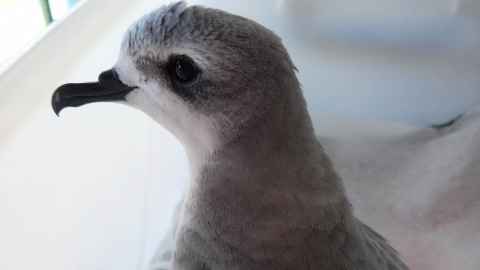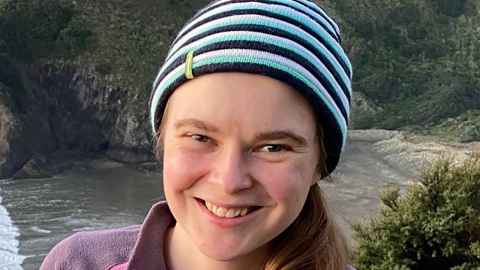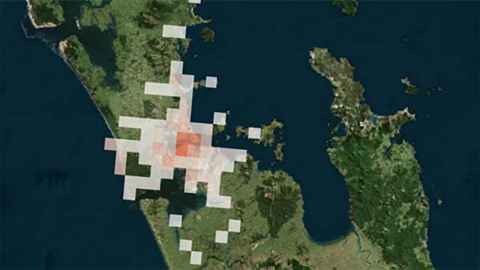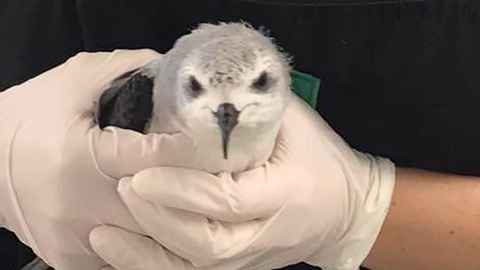Light pollution’s deadly toll on Auckland seabirds
19 October 2022
Light pollution is taking a deadly toll on the seabirds of the Hauraki Gulf.

Light pollution’s toll on Auckland’s seabirds has been mapped in detail for the first time, with the Sky Tower and central business district featuring as hot spots for deaths and injuries.
PhD student Ariel-Micaiah Heswall, of Waipapa Taumata Rau, University of Auckland, mapped where 365 seabirds, apparently disoriented by light, crash-landed over a four-year period (2018-2021).

Key facts:
- Groundings were highest in the central business district, the place with the worst light pollution
- April was the worst month because of birds’ migration patterns
- The Cook’s petrel (tītī) was the worst-affected species
- The greater the light pollution, the greater the likelihood of groundings
Of the 365 birds to ground, often after colliding with buildings, about half (185) died from their injuries. Typically, survivors nursed back to health by BirdCare Aotearoa are released at dusk at Te Henga (Bethells Beach) or Piha on Auckland’s west coast.
“New Zealand is a biodiversity hotspot containing about a quarter of the world’s seabird species and no less than 27 seabird species breed in the Hauraki Gulf,” says Heswall. “The location of New Zealand’s biggest city, with all its lights, is proving to be a real problem for Aotearoa’s taonga seabirds.”
Light pollution is an increasing problem for a range of animals and contributes to the death of millions of birds each year
Fledglings which have just left the nest are very vulnerable because of their inexperience and if they’re petrels or shearwaters even more so, because of their under-developed vision, likely a result of being raised in dark burrows.
Once grounded, often with head and internal trauma and wing and leg injuries, the birds are stuck, since they’re poorly suited to taking off from the flat.
“Twelve seabirds were grounded around the Sky Tower alone between 2018 and 2021,” says Heswall. “Sadly, we still do not know the full extent of light pollution’s toll because some birds will be trapped on rooftops or in obscure spots such as drains.”
In April, Heswall and volunteers regularly patrolled the CBD for grounded Cook’s petrels, something she plans to continue in coming years from March to May, when groundings are most likely.

“There are ways for people and local authorities to help,” says Heswall. “Building owners can turn off lights during migration seasons. You can close curtains in your apartment or office space at night. Streetlights can be shielded. The lighting of individual buildings and structures can be altered to be more bird friendly.”
She’s raising awareness by campaigning for the Cook's petrel to be Bird of the Year in the annual contest run by the conservation organization Forest & Bird. (Voting opened this week.)
Besides the Cook’s petrel, the Hauraki Gulf seabirds which fall victim to light pollution include:
- grey-faced petrel
- black petrel
- Buller’s shearwater
- fluttering shearwater
- common diving petrel
- white-faced storm petrel
- sooty shearwater
The Cook’s petrel is a small grey and white bird, which can fly thousands of kilometres. Aucklanders hear its “kek-kek-kek” calls at night during summer and spring when the birds are crossing the isthmus to feed in the Tasman Sea.
At this time of year, the birds have finished breeding and are spending time in the North Pacific.
In November and December, they will return to their burrows on Little Barrier Island (Te Hauturu-o-Toi), Great Barrier Island (Aotea) and Codfish Island (Whenua Hou), laying eggs and raising chicks which will leave the nest around March-April.

In Heswall’s research paper, heat maps show how seabird groundings are connected to levels of light pollution.
Seabirds were found beside lamp posts at Kohimarama Beach and Mission Bay, in Albert Park and Hobson Street in the central business district, Opou Reserve in Titirangi, and Kitchener Road in Waiuku. They also grounded at Browns Bay, Piha, Muriwai and Bethells Beach – among many others.
Fewer groundings were reported in rural areas than in the hotspot of the central business district, except for brightly lit rural areas, the paper says.
Bird New Zealand appreciates efforts to educate the public about light pollution and the country’s diverse seabirds, says regional representative Ian McLean.
“Many people are unaware of the species of bird that they may find, with grounded Cook's petrels often mistaken for feral pigeons or even New Zealand dotterels,” says McLean.
Light pollution is an increasing problem for a range of animals and contributes to the death of millions of birds each year. #DimLightForBirds was the hashtag for World Migratory Bird Day on 8 October.
The data for the Auckland study came from BirdCare Aotearoa. Heswall’s collaborators included Dr Lynn Miller from BirdCare Aotearoa, Dr Ellery McNaughton from the University of Auckland, Dr Amy Martin from Manaaki Whenua – Landcare Research, Dr. Megan Friesen from Saint Martin’s University in Washington state, and Dr Kristal Cain and Dr Anne Gaskett from the University of Auckland.
“Where are they landing? Mapping seabird fallout from artificial lighting in urban Auckland, New Zealand” was published in the journal PeerJ.
Media contact
Paul Panckhurst | media adviser
M: 022 032 8475
E: paul.panckhurst@auckland.ac.nz